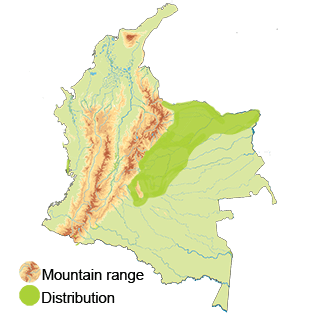Brazilian Teal
Appearance: The Brazilian Teal is a small-sized duck (41 cm - 16 in), with males and females displaying sexual dimorphism. Males have a rich chestnut-colored head and neck, contrasting with a glossy dark green body. Pale cheeks. They have a distinctive white crescent-shaped mark on their face. Raspberry red bill and feet. Females have a brownish plumage with paler underparts and a mottled pattern. Both sexes have a bright reddish-brown eye and a gray to dusky bill.
Habitat: Brazilian Teals inhabit a variety of freshwater wetland habitats, including rivers, streams, ponds, lakes, marshes, and flooded grasslands. They prefer areas with emergent vegetation that provide cover and nesting sites. In Colombia, they can be found in different regions with suitable habitats, including along river systems and wetland complexes up to 500 m.
Behavior: This species is known for its active and social behavior. Brazilian Teals typically forage in shallow water, where they feed on a variety of aquatic plants, seeds, invertebrates, and small aquatic organisms. They may also graze on land, consuming grasses and agricultural crops. They often form small groups or pairs, and their flight is typically low and swift.
Breeding: Breeding periods can vary across their range, including in Colombia. Brazilian Teals often form monogamous pairs during the breeding season. The female builds a nest on the ground, concealed within vegetation. She lays a clutch of 8-10 eggs, which she incubates for about a month. After hatching, the young ducklings are precocial and follow their parents to find food and learn survival skills.
Conservation Status: The Brazilian Teal is generally considered a species of least concern in terms of global conservation status.
Distribution
Orinoco River Basin: The Brazilian Teal is known to inhabit wetland areas and rivers within the Orinoco River Basin, including regions such as Vichada, Meta, Casanare, and Arauca.
Amazon Basin: The Brazilian Teal is also present in the Amazon Basin within Colombia, specifically in regions such as Vaupés, Guainía, Guaviare, and Amazonas.
Eastern Plains: The wetland complexes and rivers in the eastern plains of Colombia, particularly areas in the departments of Casanare, Meta, and Vichada, are home to populations of the Brazilian Teal.
Coastal Wetlands: Along the Caribbean coast of Colombia, including areas such as La Guajira, Cesar, and Bolivar, there are coastal wetlands and lagoons where the Brazilian Teal can be found.
Magdalena River Basin: The Brazilian Teal has been reported in wetlands and rivers throughout the Magdalena River Basin in Colombia, including regions like Huila, Tolima, and Cundinamarca.
Taxonomy
- Kingdom: Animalia (Animals)
- Phylum: Chordata
- Class: Aves (Birds)
- Order: Anseriformes
- Family: Anatidae
- Genus: Amazonetta
- Species: Amazonetta brasiliensis
Vocalization
Whistling Calls: The Brazilian Teal is known for its distinctive whistling calls. These calls are often soft and high-pitched, resembling a series of clear, melodious whistles. Individuals may produce these calls both during flight and while on the water.
Contact Calls: Brazilian Teals utilize contact calls to maintain contact with their flock members. These calls are characterized by short, sharp notes or chattering sounds. They help to keep the group together and coordinate their movements.
Alarm Calls: When threatened or alarmed, Brazilian Teals emit a rapid series of loud, repeated quacking or harsh notes. These alarm calls serve to alert other individuals in the vicinity to the potential danger.
Courtship Calls: During the breeding season, male Brazilian Teals produce specific vocalizations as part of their courtship displays. These calls can include low rattling or croaking sounds combined with soft whistles to attract females and establish their territory.





